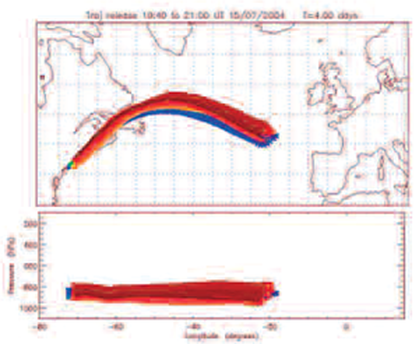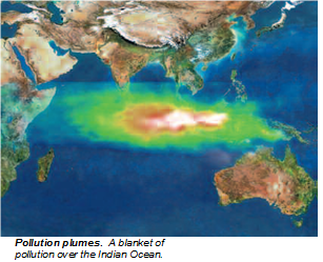Pollution: from city streets to global atmosphere
Upper Troposphere Lower Stratosphere (UTLS)
Air pollution is often thought of as a local issue affecting just small areas, for example, around towns and cities. Consequently, policy makers largely monitor and control air pollution at a local level. It has become increasingly clear however that, over the past decade, surface emissions from manmade sources can and do travel on continental scales.
City pollution in the lowermost atmosphere does not travel far. The major factor in longer-range movement of pollution is the up-lift of air from the boundary layer into the free troposphere lying above. The troposphere is split into two regions; the1-2km nearest the Earth’s surface is the boundary layer, and the region above it is the free troposphere.
Air pollution is often thought of as a local issue affecting just small areas, for example, around towns and cities. Consequently, policy makers largely monitor and control air pollution at a local level. It has become increasingly clear however that, over the past decade, surface emissions from manmade sources can and do travel on continental scales.
City pollution in the lowermost atmosphere does not travel far. The major factor in longer-range movement of pollution is the up-lift of air from the boundary layer into the free troposphere lying above. The troposphere is split into two regions; the1-2km nearest the Earth’s surface is the boundary layer, and the region above it is the free troposphere.
Our understanding of the effect of long-range pollution transport has relied heavily on the use of computer models but there has been only limited use of observations to validate such models. Providing validation from observations requires researchers to address the following questions. Can we detect a polluted air mass leaving a city or region and follow this as it evolves over thousands of miles? How does the composition change over time? Where do the emissions end up? To answer these questions requires a massive experimental and computational challenge, requiring models to make highly accurate predictions of weather and atmospheric transport, in combination using aircraft to make detailed and source-unique measurements, by flying into remote regions of the atmosphere. A successful coupling of model and measurements in the field provides the key validation of model performance, and from this, quantitative estimates of emissions and impacts.
|
Once in the middle and upper troposphere, jet streams can move these gases and aerosols (small particles) thousands of miles, often in distinct stratified layers of pollution rich air. Based on observations and computer models, researchers now propose that for a wide range of atmospheric pollutants, this is the main method of transport on large scales. The transport of pollutants can therefore be considered as being ‘embedded’ within weather systems themselves, and has lead to the concept of chemical weather. Many different meteorological processes can aid the redistribution of surface pollutants from local to global, for example large-scale advection (horizontal movement), deep convection and convection embedded within frontal systems. Long-range transport of pollutants such as nitrogen oxides and volatile organic compounds can lead to further increases in free troposphere concentrations of ozone (formed when nitrogen dioxide is exposed to sunlight) and aerosols downstream, of significance to climate change researchers.
|
Over recent years NERC has supported a substantial amount of UK-led research in this area. Through the UTLS programme, scientists have placed a considerable emphasis on a better understanding of the mechanisms through which pollutants leave the boundary layer and enter the free troposphere. The project ‘dynamics and chemistry of frontal zones’ quantified the efficiency with which fronts sweep up surface level pollutants and pass them into the free troposphere. The project ‘atmospheric chemistry and transport of ozone’ laid the foundations for the detection of reactive and short lived chemical pollutants as a means of differentiating between advection and convection as mechanisms for pollutant transport into the free troposphere.
In addition, when air subsides many thousands of miles downwind of its source, it may result in elevated pollutant concentrations re-entering the boundary layer. Any such increase in what may be considered the ‘baseline’ concentration prior to further local or regional production, may have significant impact in determining feasible local air quality targets, and will raise exposure levels of people, animals and vegetation to certain pollutants.
|
One of the largest atmospheric chemistry experiments ever staged, the International Consortium for Atmospheric Research into Transport and Transformation (ICARTT), addressed this issue for the first time. The UK, through UTLS, funding was a lead participant in this multinational project involving some 600 scientists and 100 agencies and research organisations. One of the overarching goals of ICARTT was to make detailed observations of chemical processing and change occurring in air moving from the USA to Europe. This involved intercepting and sampling, on many occasions, polluted air from coastal cities along the eastern seaboard of the USA, as it passed out over the Atlantic and on to Europe. UK scientists provided the key mid-Atlantic measurements, flying the NERC/Met Office aircraft into air masses that had been sampled on previous days by US research aircraft, and which would be studied once over Europe by French and German scientists.
|
The key achievement from ICARTT was that polluted air masses from the US could indeed be identified using specialised forecasts, and then successfully intercepted and re-sampled by up to four different aircraft over seven days and distances of up to 4000 miles. This was the first time that scientists have been able to follow a true source-to-receptor pathway for pollutants moving over intercontinental scales. To achieve this the teams needed to develop new tools and approaches for both forecasting and flight planning, in addition to high quality and highly detailed chemical measurements made from aircraft. By combining both measurements and models the project has made much more accurate estimates of emission strengths and long-range influence of pollutants.
Prof. ALISTAIR LEWIS
Department of Chemistry,
University of York
[email protected]
This article originally appeared in the Natural Environment Research Council publication Our Changing Atmosphere and is reproduced here with the permission of the author. The complete article may also be seen on the ECG page of the RSC’s web site at http://www.rsc.org/Membership/Networking/InterestGroups/Environmental/bulletin.asp
Prof. ALISTAIR LEWIS
Department of Chemistry,
University of York
[email protected]
This article originally appeared in the Natural Environment Research Council publication Our Changing Atmosphere and is reproduced here with the permission of the author. The complete article may also be seen on the ECG page of the RSC’s web site at http://www.rsc.org/Membership/Networking/InterestGroups/Environmental/bulletin.asp



